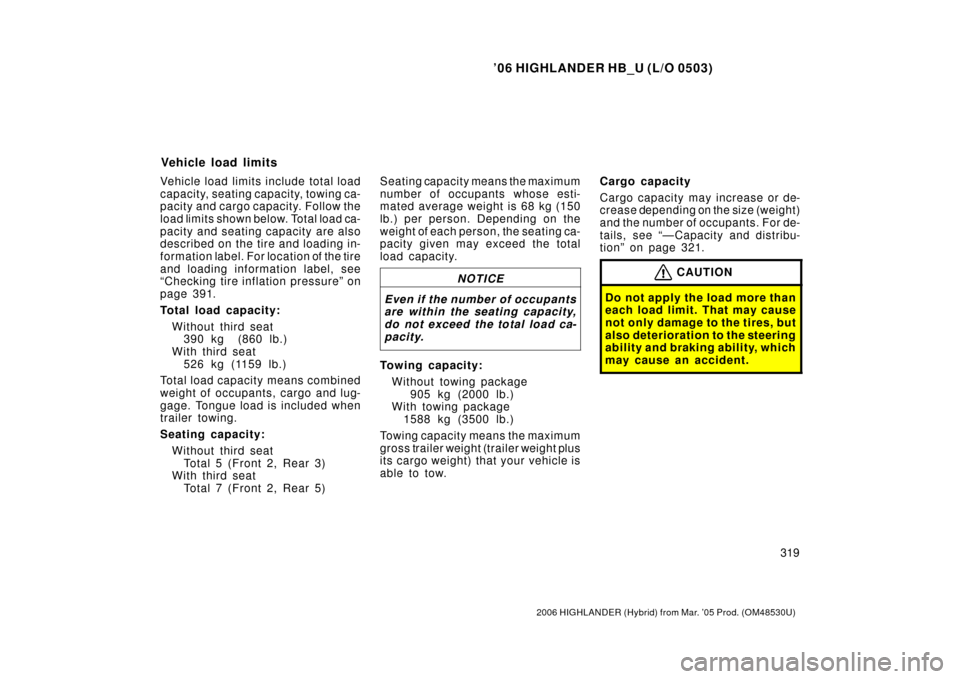Page 9 of 436

’06 HIGHLANDER HB_U (L/O 0503)
ix
2006 HIGHLANDER (Hybrid) from Mar. ’05 Prod. (OM48530U)
Tires and loading on your
To y o t a
Underinflated or overinflated tire pressure and the
excess load may result in the deterioration of
steering ability and braking ability, leading to an
accident. Check the tire inflation pressure periodi-
cally and be sure to keep the load limits given in
this Owner ’s Manual. For details about tire inflation
pressure and load limits, see pages 391 and 319.
On�pavement and off�road
driving tips
This vehicle belongs to the utility vehicle class. Utility ve-
hicles have a significantly higher rollover rate than other
types of vehicles. This vehicle will handle and maneuver
differently from an ordinary passenger car. In addition, this
vehicle has a higher ground clearance and center of gravi-
ty than that of an ordinary passenger car. This vehicle de-
sign feature causes this type of vehicle to be more likely
to rollover. Failure to operate this vehicle correctly may
result in loss of control, accidents or vehicle rollover caus-
ing death or serious injury. Be sure to read “Utility vehicle
precautions” on page 300 in Section 2 and “Off −road driv-
ing precautions” on page 328 in Section 3.
Page 102 of 436
’06 HIGHLANDER HB_U (L/O 0503)
90
2006 HIGHLANDER (Hybrid) from Mar. ’05 Prod. (OM48530U)
The angle of
vehicle tip−up
is marginal Skidding vehicle
hitting a curb
stone
The SRS curtain shield airbags may in-
flate if the angle of vehicle tip�up is
marginal or if the skidding vehicle’s
tires hit a curb stone laterally as shown
in the illustration.
Collision from
the front
Collision from
the rear
Pitch end over end
The SRS curtain shield airbags are not
generally designed to inflate if the ve-
hicle is involved in a front or rear colli-
sion, if it pitches end over end, or if
it is involved in a low�speed side colli-
sion.
Hitting a curb,
edge of pavement
or hard surface Falling into or
jumping over a
deep hole
Landing hard or vehicle falling
The SRS side and curtain shield airbags
may deploy if a serious impact occurs
to the underside of your vehicle. Some
examples are shown in the illustration.
Page 324 of 436

’06 HIGHLANDER HB_U (L/O 0503)
312
2006 HIGHLANDER (Hybrid) from Mar. ’05 Prod. (OM48530U)
7. “TUBELESS” or “TUBE
TYPE”— A tubeless tire does not
have a tube inside the tire and air
is directly filled in the tire. A tube
type tire has a tube inside the tire
and the tube maintains the air
pressure.
8. Load limit at maximum cold tire inflation pressure— For details,
see “Checking and replacing tires”
on page 393.
9. Maximum cold tire inflation pressure— This means the pres-
sure to which a tire may be in-
flated. For details about recom-
mended cold tire inflation
pressure, see “Tires” on page 415.
10.Summer tire or all season tire— An all season tire has “M+S”
on the sidewall. The tire not
marked with “M+S” is a summer
tire. For details, see “Types of
tires” on page 322.
This illustration indicates typical DOT
and Tire Identification Number (TIN).
1. “DOT” symbol
2. Tire Identification Number (TIN)
3. Tire manufacturer ’s identification mark
4. Tire size code
5. Manufacturer ’s optional tire type code (3 or 4 letters)
6. Manufacturing week
7. Manufacturing year The “DOT” symbol certifies that the
tire conforms to applicable Federal
Motor Vehicle Safety Standards.
—DOT and Tire Identification
Number (TIN)
Page 327 of 436

’06 HIGHLANDER HB_U (L/O 0503)
315
2006 HIGHLANDER (Hybrid) from Mar. ’05 Prod. (OM48530U)
Temperature A, B, C—T he tem per a-
ture grades are A (the highest), B,
and C, representing the tire’s resis-
tance to the generation of heat and
its ability to dissipate heat when
tested under controlled conditions on
a specified indoor laboratory test
wheel. Sustained high temperature
can cause the material of the tire to
degenerate and reduce tire life, and
excessive temperature can lead to
sudden tire failure. The grade C cor-
responds to a level of performance
which all passenger car tires must
meet under the Federal Motor Vehicle
Safety Standard No.109. Grades B
and A represent higher levels of per-
formance on the laboratory test wheel
than the minimum required by law.
Warning: The temperature grades for
this tire are established for a tire that
is properly inflated and not over-
loaded. Excessive speed, underinfla-
tion, or excessive loading, either sep-
arately or in combination, can cause
heat buildup and possible tire failure.
Page 328 of 436

’06 HIGHLANDER HB_U (L/O 0503)
316
2006 HIGHLANDER (Hybrid) from Mar. ’05 Prod. (OM48530U)
Ti r e relat ed ter mMeaning
Accessory weight
the combined weight (in excess of those standard items which may be
replaced) of transaxle, power steering, power brakes, power windows,
power seats, radio, and heater, to the extent that these items are available
as factory−installed equipment (whether installed or not)
Cold tire inflation pressure
tire inflation pressure when the vehicle has been parked for at least 3
hours or more, or it has not been driven more than 1.5 km or 1 mile
under that condition
Curb weight
the weight of a motor vehicle wi th standard equipment including the
maximum capacity of fuel, oil, and coolant, and, if so equipped, air
conditioning and additional weight optional engine
Intended outboard sidewall
(A) the sidewall that contains a whitewall, bears white lettering or bears manufacturer, brand, and/or model name molding that is higher or
deeper than the same molding on th e other sidewall of the tire, or
(B) the outward facing sidewall of an asymmetrical tire that has a particular side that must always face outward when mounted on a vehicle
Maximum inflation pressurethe maximum cold inflation pressure to which a tire may be inflated and it
is shown on the sidewall of the tire
Maximum loaded vehicle weight
t he sum of —
(a) curb weight;
(b) accessory weight;
(c) vehicle capacity weight; and
(d) production options weight
—Glossary of tire terminology
Page 329 of 436

’06 HIGHLANDER HB_U (L/O 0503)
317
2006 HIGHLANDER (Hybrid) from Mar. ’05 Prod. (OM48530U)
Ti r e relat ed ter mMeaning
Normal occupant weight68 kg (150 lb.) times the number of occupants specified in the second
column of Table 1 that follows
Occupant distributiondistribution of occupants in a vehicle as specified in the third column of Table
1 that follows
Production options weight
the combined weight of those installed regular production options weighing
over 2.3 kg (5 lb.) in excess of those standard items which they replace,
not previously considered in curb weight or accessory weight, including
heavy duty brakes, ride levelers, roof rack, heavy duty battery, and special
trim
Recommended inflation pressurecold tire inflation pressure recommended by a manufacturer
Rima metal support for a tire or a tire and tube assembly upon which the tire beads
are seated
Rim diameter (Wheel diameter)nominal diameter of the bead seat
Rim size designationrim diameter and width
Rim type designationthe industry of manufacturer ’s designation for a rim by style or code
Rim widt hnominal distance between rim flanges
Vehicle capacity weight
(Total load capacity)the rated cargo and luggage load plus 68 kg (150 lb.) times the vehicle’s desig-
nated seating capacity
Vehicle maximum load on the tirethe load on an individual tire that is determined by distributing to each axle
its share of the maximum loaded vehicle weight and dividing by two
Page 330 of 436
’06 HIGHLANDER HB_U (L/O 0503)
318
2006 HIGHLANDER (Hybrid) from Mar. ’05 Prod. (OM48530U)
Ti r e relat ed ter mMeaning
Vehicle normal load on the tire
the load on an individual tire that is determined by distributing to each axle
its share of the curb weight, accesso ry weight, and normal occupant weight
(distributed in accordance with Table 1 that follows) and dividing by two
Weather sidethe surface area of the rim no t covered by the inflated tire
Table 1—Occupant loading and distribution for vehicle normal load for various designated seating capacities
Designated seating capacity,number of occupants
Vehicle normal load, number of occupantsOccupant distribution in a normallyloaded vehicle
2 through 422 in front
5 through 1032 in front, 1 in second seat
Page 331 of 436

’06 HIGHLANDER HB_U (L/O 0503)
319
2006 HIGHLANDER (Hybrid) from Mar. ’05 Prod. (OM48530U)
Vehicle load limits include total load
capacity, seating capacity, towing ca-
pacity and cargo capacity. Follow the
load limits shown below. Total load ca-
pacity and seating capacity are also
described on the tire and loading in-
formation label. For location of the tire
and loading information label, see
“Checking tire inflat ion pr es s ur e” on
page 391.
Total load capacity:
Without third seat390 kg (860 lb.)
With third seat 526 kg (1159 lb.)
Total load capacity means combined
weight of occupants, cargo and lug-
gage. Tongue load is included when
trailer towing.
Seating capacity:
Without third seatTotal 5 (Front 2, Rear 3)
With third seat
Total 7 (Front 2, Rear 5) Seating capacity means the maximum
number of occupants whose esti-
mated average weight is 68 kg (150
lb.) per person. Depending on the
weight of each person, the seating ca-
pacity given may exceed the total
load capacity.
NOTICE
Even if the number of occupants
are within the seating capacity,
do not exceed the total load ca-
pacity.
Towing capacity:Without towing package 905 kg (2000 lb.)
With towing package
1588 kg (3500 lb.)
Towing capacity means the maximum
gross trailer weight (trailer weight plus
its cargo weight) that your vehicle is
able to tow. Cargo capacity
Cargo capacity may increase or de-
crease depending on the size (weight)
and the number of occupants. For de-
tails, see “—Capacity and distribu-
tion” on page 321.
CAUTION
Do not apply the load more than
each load limit. That may cause
not only damage to the tires, but
also deterioration to the steering
ability and braking ability, which
may cause an accident.
Veh icle lo ad limit s